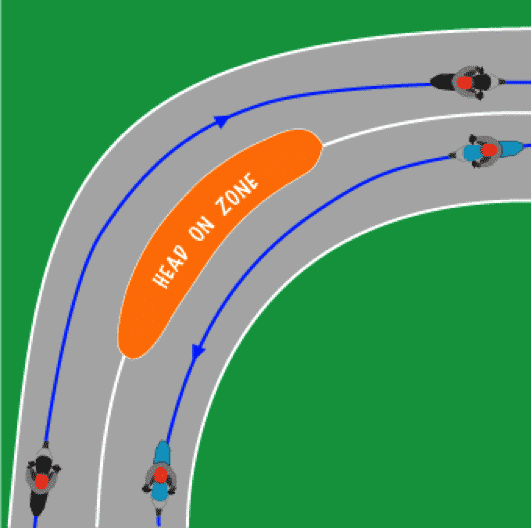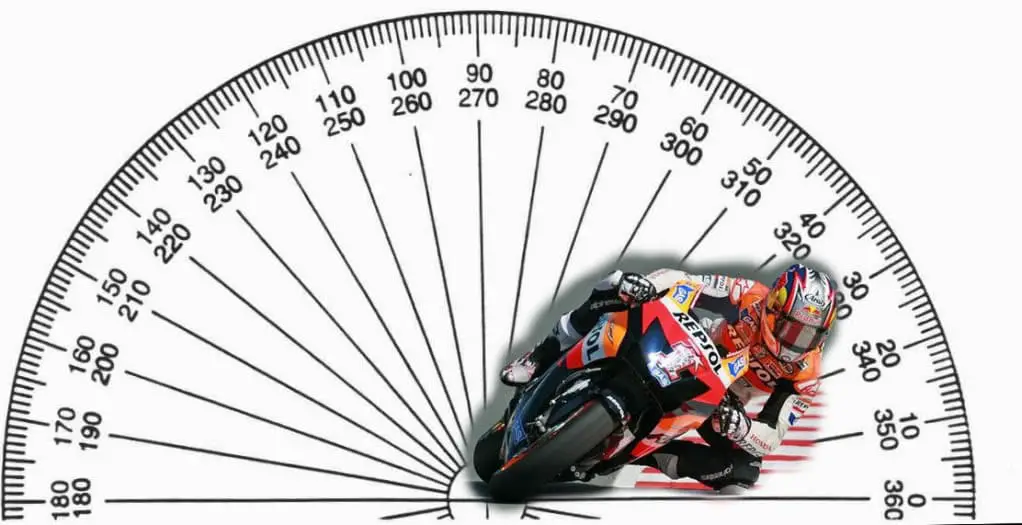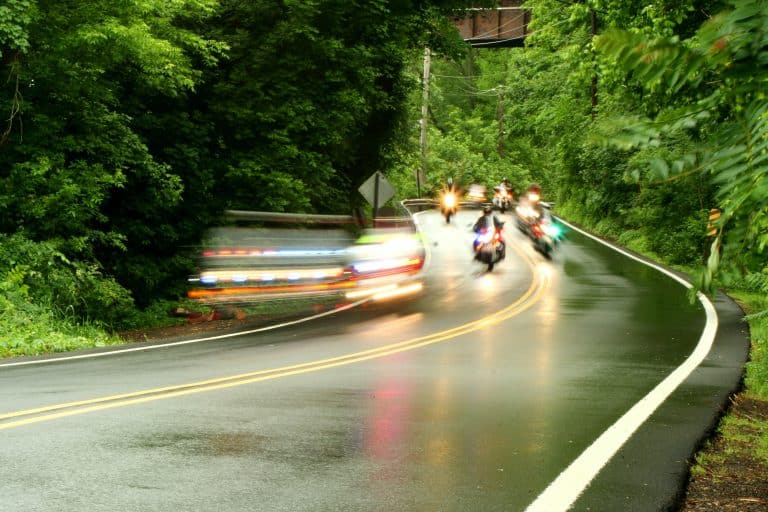The only safe way to ride a motorcycle is to predict the unpredictable. And Nothing is more unpredictable than curves and corners.
Imagine this, you’re halfway around your corner and an old lady is in the middle of the road. When pushed into a dangerous situation like this during a curve you have two options: swerve to change your direction or stop. Both are difficult maneuvers to perform but today we will elaborate on what to do to stop during a curve.
Safest & fastest way to stop a motorcycle in a curve:
- Road Position: Counter-steer deeper towards the inside lane
- Stand Bike Up: Straighten your bike up
- Perform Emergency Stop
Performing a stopped motorcycle in a curve is one of the most difficult things to do on a motorbike. It requires both skills, re-action speed, and knowledge about how to slow down the bike, which takes some time to master. There are many techniques that are combined together in this stopping maneuver, don’t expect it to be perfect from the first time.
Let’s break these down…
1. Road Position (Where is your Front Wheel pointed?)
Let’s say you’re smashing that corner, you’ve bent your bike over so much Rossi would be proud! Then suddenly you need to stop.
Well, we all know, to stop we need to straighten up our bikes.
BUT if you take curves anything like me, straightening up halfway through a turn would put us too wide in the lane and possibly off the road. This is because of the arch of your turning circle. The arch of your turning circle is an imaginary line that follows the angle your bike would continue if you changed nothing.

Another way to think about the arch of your turning circle is to think about where your front wheel’s pointing. You see, in a count-steer with a lean angle, your bike’s front wheel will naturally point towards the outside of the lane. The moment you straighten your bike up, your counter-steer disappears and you’re heading towards those trees off the road.
So what can you do about it?
The solution, counter-steer deeper towards the inside lane until the arch of your bike straightens up. Then when you straighten the bike up you won’t end up running yourself off the road.
Doing this should be performed with extreme caution, increasing your counter-steering then suddenly straightening up your bike will feel a lot like a dip and weave motion.
2. Stand Bike Up (Reduce lean angle)
Once your bike is facing the right way and you know you aren’t going to run yourself off the road, the second step is to stand or straighten your bike up. This is crucial to the next step (breaking) because braking at an angle almost always ends in a motorcycle accident.

And even if you were able to brake at an angle, there are some strong advantages to waiting until your bike is straight.
When your bike is straight you have the most friction on your tires, this significantly increases your stopping power. Also, you are able to use significantly more brake force on your front brake whilst being in a safe range on the front forks.
For these reasons alone, don’t start braking until you’ve stood your bike up.
3. Perform Emergency Brake/Stop
You’re in the right position and you’ve stood the bike up. All that is left is to STOP! And nothing gets you to a complete stop faster than emergency braking.
How to perform an emergency stop:
- Check mirrors (make sure no one will crash into you if you brake too hard)
- Roll-off Throttle
- Apply front brake and rear brake (prioritize the front brake)
- Clutch in (don’t worry about shifting down for now)
- Increase braking (even pressure now to unload the front fork)
- Left foot shifts to first gear
- Left foot on the ground when the bike stops moving
In an emergency situation where the hazard is extremely close, once you’ve engaged the brakes don’t let off until your motorcycle brakes fully.
Common Questions about Stopping on a Curve
How to know if I should swerve or stop in a corner?
My rule is, always slow and swerve unless you can’t. Then use this stopping maneuver to stop during a curve. Ultimately this maneuver is all for you to maintain control of your motorcycle. In a split second, you’ll need to decide what will do this best for you.
Rear Brake vs. Front Brake in Corner
Ultimately you shouldn’t be using your front brake or your rear brake while you have any lean angle, or are taking a corner.
After straightening up priorities your front brake for extra stopping force and if you absolutely had to use a brake around a corner while leaning, use the rear.
But I cannot stress this enough, good riders never get themselves in that situation. It really is dangerous to use both your front brake and your rear brake in a corner without straightening your bike up.
Should I use engine braking around a corner?
No, braking using your engine can cause your rear tire to lose grip and slide out. And once that happens you’re in a world of hurt! In this maneuver, we aren’t actually even engaging the clutch at all!
If you did have enough time or you are a more experienced rider, engaging your gears is fine to do. But still not helpful or required here.
How to Practice this Maneuver?
Practicing this maneuver would be best on an empty parking lot or road. Doing this maneuver around even a pretty slow corner can be really scary the first few times because you’re forced to go wide.
This is normal, and it’s best that your motorcycle goes out away from danger rather than into traffic! The biggest issue I see people struggle with here is swerving hard enough.
Tips to Predicting Hazards in Corners
There are two simple tips that 100% guarantee to making cornering hazards more predictable so you can anticipate them better and have more time to correct them accordingly.
Firstly, looking further ahead.
I realize that there is limited visibility during cornering but too many motorcyclists focus on the bitumen in front during a corner and not on potential hazards ahead.
Secondly, take corners slower.
I’m going to get a lot of backlash for this, but in corners that you can’t see more than a second ahead, easing off that throttle a little more could be the difference between having or not having a crash.
What happens if I brake hard during a curve?
Many riders are tempted, but whatever you do, don’t brake hard during a curve.
If you brake hard during a curve, it will most likely cause the bike to lose traction. Most bikes will end up going for a slide when the brakes are pulled during a curve.
To allow your bike to deal with braking forces your bike needs to be straightened up and not turning when braking.
What makes stopping in a curve difficult?
Always be behind your bike at all times in a group if possible and keep it strong. In a rear tire slipping when the rear wheel is not in line with the rear wheel the rear brake should be released to rapidly straighten the motorcycle. Why does stopping slowly at a curve make it a lot of work?
What to do if my bike starts to skid?
If your bike starts to skid, don’t turn into the corner or you’ll go off road and crash. If it does start to slip straighten up your bike more, ease off the brakes for the time being, and make sure that all wheels are pointing forward again. Stop brakes until the motorcycle is completely under control before continuing on with breaking.
How do Different Conditions Change this Manuver?
If you’re practicing this maneuver, you should do so in dry conditions, but if it’s wet you can still do this. Obviously, in a real-world situation, you don’t have this luxury, just remember that the surface will be slippery and braking distances are much longer than usual.
Is it ok to load the front tyre when applying front brakes?
Most riders would agree, loading your front tyre when applying front brakes is completely natural and shouldn’t be a point of concern. This is what your front forks are for.
However if a rider brakes hard during a curve (specifically with a lean angle) then the front forks are not loaded at the same time and this can have disastrous consequences.
Stopping on a curve for a Dirt-Bike vs. Road Bike
There is absolutely no difference in technique when stopping on a curve for different types of bikes.
The main difference is the amount of traction available to each and how much you can get away with doing the wrong thing.
Final Thoughts
When I started riding being able to quickly straighten up my bike and brake felt very unnatural. Coming from a car, like so many other riders, you would always just brake during the corner.
But as I practiced this maneuver with the increasingly shortest distance my confidence grew and it has definitely made me a better rider. Everyone can drive in a straight line, brake, and corner. But not very many are able to combine all three safely and to do so in so few seconds as you get around a corner.






